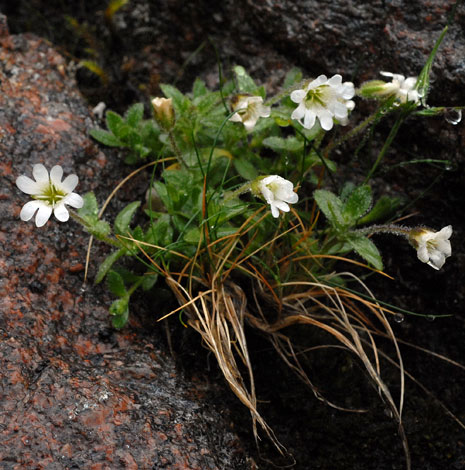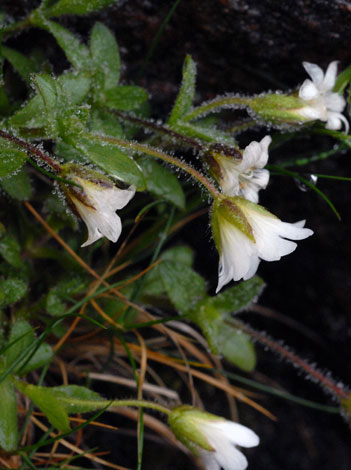Cerastium nigrescens var laxum Arctic Mouse-ear RR DDD N


The name for this species is changing in British floral lists and texts but not consistently. Work done on the Cerastium arcticum species growing in or near the arctic circle shows them to significantly different from the southerly species which grow in the British Isles. The proposal (see link below), accepted by New Flora of the British Isles Third Edition by Clive Stace, Kent's lists, the BSBI lists but not yet the BSBI mapping data at November 2010 is that our British species long known as Cerastium arcticum should be re-named Cerastium nigrescens var laxum.
This however is not a new name. Cerastium nigrescens was the systematic name for Shetland Mouse-ear so the new name suggests that there is no unique species growing Shetland - all Cerastium arcticum species including old Cerastium nigrescens in Shetland are now Arctic Mouse-ear and all are Cerastium nigrescens. So yet another plant (like Epipactis youngiana) has an action plan designed to save it when it no longer exists as a unique species. Stace recommends that the Shetland plant which has purplish tinged broad leaves and abundant glandular hairs be recognised as a variety and named Cerastium nigrescens var nigrescens but concedes that perhaps it should at least have sub species rank.
See Trans-atlantic dispersal and phyleogeography of Cerastium arcticum (Caryophyllaceae) inferred from RAPD and SCAR markers by R Hagen, H Giese and C Brochmann (March 2000) Link here
So our British mainland plant is: C. nigrescens var laxum (H. C. Watson) Edmondston ex H. C. Watson (Brysting and Elven, 2000)
and the plant growing in the Arctic regions is C. arcticum sensu stricto (cf. Hultén, 1956)
Cerastium nigrescens (Arctic mouse-ear) is much more difficult to separate morphologically from Cerastium alpinum (Alpine Mouse-ear) than I had thought. The flower is slightly reflexed in C. nigrescens but both are hairy with considerable variations possible in the hair features. The most convincing evidence is habitat. C. nigrescens is usually an acid rock species (although C. nigrescens var nigrescens grows on Serpentine) with C. alpinum usually a calciole. This specimen shown here is growing right out of the red granite of the Cairngorm on wet misty day when the visibility was only 30 or 40 metres. C. nigrescens var laxum has more glandular hairs supposedly but the "glands" you can see in the photo are actually drops of water.
Access for this specimen meant first driving to the highest car park in the land at the Cairngorm Ski lift centre then following the track towards the Northern Corries. This track has improved immeasurably since I last came with solid granite stones laid into the path for quite a distance. Eventually though you have to cross boulder fields and near the cliffs of Coire an t-Sneachda where this species lives, the small rocks and pebbles are all unstable. Two sticks were vital. If you have any doubts about this type of expedition then don't go but if you do go then always go with a friend for safety reasons.
It is found mostly in Scotland with just one outpost in Snowdonia (where I haven't been able to find it yet).
Coire an t-Sneachda, Cairngorms, Scotland 18th July 2007
Added on 20th Jul 2007, updated 27th Nov 2008, updated 12th Mar 2010, updated Se3 30th Apr2010, 11th Jan 2011



